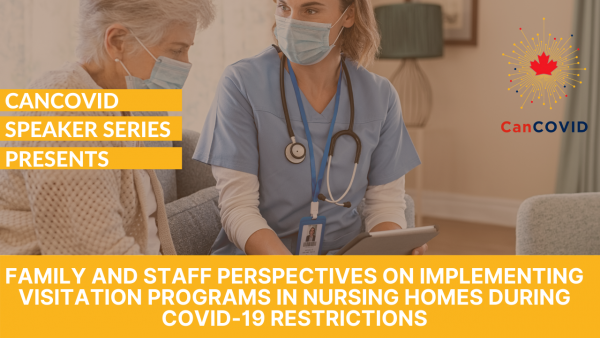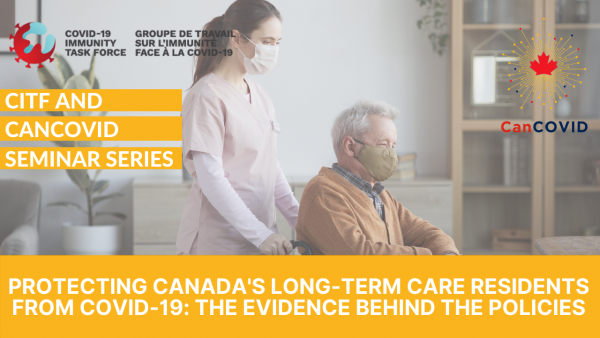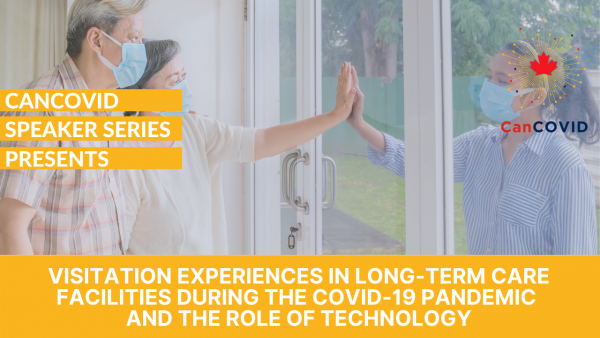Impact of Restrictive Public Health Measures on Long-Term Care Residents, Family, and Staff
Question: What is the impact of the COVID‑19 restrictive public health measures on the residents of long-term care homes, their family, and long-term care home staff, in terms of psychosocial, caregiving, and financial challenges?
Executive Summary
At the beginning of the pandemic, a disproportionate number of residents in long-term care (LTC) were dying from COVID‑19 in Canada and it had a devastating impact. Mortality rates in long-term care homes were as high as 64%, compared to pre-pandemic annual mortality rates of between 27% and 52%.
The different waves of the COVID‑19 pandemic brought the imposition, lifting, and in some cases, re-imposition of restrictive public health measures in long-term care homes (or nursing homes). Such measures included visitor restrictions, restrictions on staff and resident movements, and pausing of recreational activities. The question of effectiveness – whether measures were effective in reducing the transmission of COVID‑19 – is beyond the scope of this Issue Note. This paper describes the impacts of restrictive measures on nursing home residents, families, and staff.
Key findings on the impacts of restrictive public health measures in nursing homes are as follows:
- Impact on residents: this includes acute loneliness, depression, mood and behaviour issues, and worsened signs and symptoms of dementia. Many of these existed prior to the pandemic and were worsened due to restrictive measures. Residents with cognitive impairment and dementia were rarely studied, hence less is known about the impacts on this group except the acknowledgement that there was a significant increase in psychotropic medication use during the pandemic.
- Impact on families and friends as caregivers: this includes psychological impacts and impacts relating to the disruption in their caregiving roles. Families experience double trauma in that they are affected by the impacts on their loved ones and suffer their own psychological pain as well. Seen as vital to the wellbeing of residents, the informal care and support they provided, when absent due to restrictions, was acutely felt by residents (who suffered decline in terms of wellbeing) and staff (who were left without the additional help families provided).
- Impact on staff: long-term care staff also experienced psychological impacts and impacts relating to changes in their role, care processes, and increased workloads. Psychological impacts differed from family members in that staff had unique anxieties relating to being the enforcers of restrictive policies, being blamed for bringing in and spreading COVID‑19 and being demoralized by negative media coverage of nursing homes compared to the heroic recognition given to hospital workers.
- Impact on safety and rights: there is a need for balance, proactive planning, and mitigation of risks. Due to significant impacts, there is a need to ‘find a balance’ between safety and rights and many agree that measures that increase isolation must be accompanied by mitigation measures or proactive preparation to augment staffing and work processes to accommodate the measures. There is a need for a balanced approach; one that both prevents the introduction of COVID‑19 into nursing homes, but which also allows family to provide much-needed contact, support, and care to residents. The opinion in most papers reviewed in this paper is that blanket visitor bans should be avoided.
- Impact of vaccinations on cases and deaths: there is a need to focus more on infection control than restrictive measures. With evidence emerging on the successful impact of vaccination on long-term care cases and deaths, a relatively greater emphasis could be put on the use of infection control rather than restrictive measures, focusing instead on masking, physical distancing, and hand hygiene. However, the recent trauma of nursing home infections and deaths, may hold back nursing homes and families from fully implementing and enjoying less restrictive measures, even when they are able to do this. Already, the media is reporting that many are ‘vaccinated and still lonely and locked inside’.
Limitations
- Relevant information may have been missed given that the search and report were completed within a short timeframe.
- We did not assess the quality of the evidence.
- Given the state of the evidence, some of the information and key considerations are based on anecdotal evidence and are matters of expert opinion and not evidence.
- Only English-language resources were consulted.
Future research and knowledge gaps
Future research is necessary to ascertain the following:
- Impacts on nursing home residents who have dementia, since majority of qualitative studies survey residents without dementia.
- Impacts of restrictions on nursing home staff who are predominantly women from minority groups for whom there are known associations with high job turnover, low wages, as well as a lack of institutional and societal support.
- Cultural influences on how restrictive measures are perceived across different groups – for instance, some Asian cultures more readily accept restrictive measures in nursing homes.
- Understanding the financial impacts of restrictions on caregivers and staff with respect to, for example, foregone income, precarious employment arrangements, and reduced financial support – topics that have received limited investigation to date.
- Whether mental health outcomes improve for residents from the use of remote communication technology, which is seen as an alternative for in-person visits. Direct resident surveys on satisfaction and impact of these technologies on their mental health are rare.
- Impact of restrictions other than visiting restrictions – which are understudied. This includes impacts on restricted movement and transportation (which can affect access to health care and services), and restricted resident activities (including recreational activities and common dining).
- The impact of ageism in the design and implementation of restrictive measures in nursing homes. Ageism is seen by some experts as the supporting belief system which has encouraged the devaluing of older adults, maintained the underinvestment of nursing homes, and informed the design of restrictive measures.





